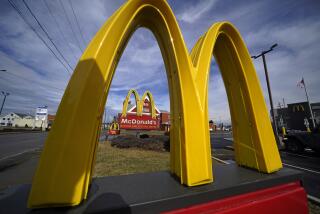Mad cow disease found in one Central Valley bovine
FRESNO — The first confirmed case of mad cow disease in the U.S. since 2006 surfaced in California’s Central Valley on Tuesday, triggering concerns about food safety. But health officials stressed that the diseased animal never entered the human food chain and that U.S. beef and dairy products are safe.
The diseased cow “was never presented for slaughter for human consumption, so at no time presented a risk to the food supply or human health,” John Clifford, the U.S. Department of Agriculture’s chief veterinarian, said in a statement.
Mad cow disease was most famously imprinted on the minds of consumers by a massive outbreak in the United Kingdom that killed more than 150 people and 180,000 cattle. The disease can be passed to humans who eat tainted meat. The World Health Organization says research shows that milk does not carry the disease.
Previous scares were crippling to the cattle industry. Beef exports dropped by more than 70% after the first case in 2003.
“This is a big deal. People have a lot of fear over mad cow disease and for good reason,” said Stevie Ipsen, director of communications for the California Cattlemen’s Assn. “But our country’s meat is still the safest in the world. We’re confident people will carry on eating beef.”
Cattle ranchers cited Tuesday’s confirmation of mad cow disease, or bovine spongiform encephalopathy (BSE), as proof that a sound screening system is in place.
“This clearly illustrates the firewall is working. This is only the fourth case in nine years and none of them were headed for the food supply,” said Mike Smith, a projects manager with Harris Ranch Beef in Coalinga.
But Michael Hanson, a senior scientist with Consumer Reports and a longtime critic of U.S. mad cow disease policy, said the discovery could be alarming.
In 1997 the U.S. changed the rules for cattle food. Until then, rendered cows could become part of cattle feed. The strategy was to get the disease out of the food chain and then the disease would eventually disappear.
“If it turns out this cow is less than 14 years old, it proves my biggest concern: Cattle feed is still not protected from mad cow,” he said.
“We still allow risky practices. You can’t feed cows to cows directly. But you can feed cows to pigs and chickens and then feed them to cows.”
Clifford said the cow died of an atypical strain of the disease. Officials believe it is a rare spontaneous case and not linked to contaminated food.
The diseased cow died while still on the farm. On any given day a dairy has three or four carcasses of cows that may have died from old age. Rendering companies, commonly known as “fat and bone collection,” pick them up for processing into commercial products such as makeup, chicken feed and pet food.
This cow was headed to a rendering plant in Kerman, said Dennis Luckey, executive vice president of Baker Commodities. A random sampling taken when the cow was at a transfer station in Hanford last Wednesday proved inconclusive and the sample was forwarded to the government.
The USDA tests about 40,000 cows a year. Technicians who work for rendering plants cut the head off the cow and take a sample from the brain stem that is then sent to scientists for testing.
Cattle infected with the disease have been found in the U.S. only three previous times — in a Canadian-born cow in 2003 in Washington state, in a Texas cow found in 2005 and in one in Alabama in 2006.
Clifford said data show that the safeguards that the U.S. and other countries have put in place are successful. In 2011 there were only 29 worldwide cases. The peak was 37,311 cases in 1992.
More to Read
Sign up for Essential California
The most important California stories and recommendations in your inbox every morning.
You may occasionally receive promotional content from the Los Angeles Times.











